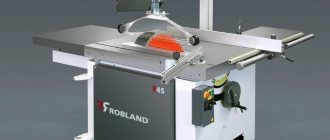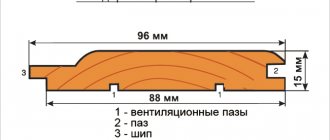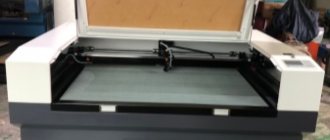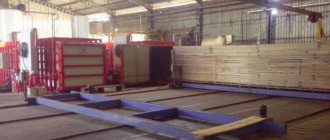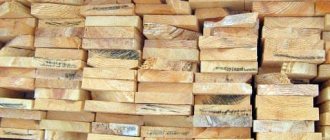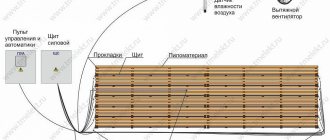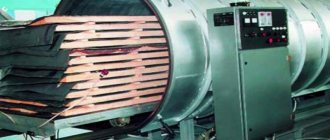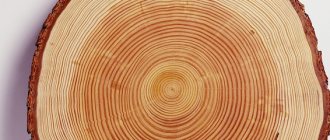Good day, dear readers of Andrey Noak’s Blog. Today I will try to answer the question - how to dry boards in production. But of course you need to start this topic with choosing a camera, since a lot depends on it. By the way, quite recently I looked at the modes of drying wood, I think the material will be useful for reading for those who are interested.
Installation
When installing a dryer and choosing equipment, you need to decide what you need, you need to take into account a number of nuances that will allow you to eliminate many problems with convective drying in the future.
Believe me, from my experience, specialized companies with big names often come, install drying chambers and... leave, and then this equipment for drying chambers needs to be modified, some kind of alterations must be made, and this costs money.
Therefore, this article is very useful for those who are just going to engage in this business. Let's turn our attention to the most important thing.
Selection of material for construction
Brick is resistant to mechanical damage, it must be plastered (it cannot withstand changes in temperature and humidity), it is more expensive, the drying process requires more energy to warm up the chamber;
An aluminum profile with a layer of various types of polymer is easily susceptible to mechanical damage (sometimes the profile is sheathed with some kind of damage-resistant material, such as lumber), less heat is required to warm up the chamber.
Making the floor
To prevent the formation of puddles in a convective dryer (further evaporation of water from puddles requires significant energy costs), the floor in the chamber is made with a slight slope, at the bottom of the slope a gutter is made along the entire length of the chamber to drain water into the street (naturally, you need to ensure the cleanliness of the gutter) . It is advisable to make the slope not towards the gate, so that the loader does not drive along the chute.
Safety
Racks are installed behind and in front of the convection dryer to prevent packages from falling onto the wall. When loading packages into the chamber, it is not always possible to lay the packages flat, and during the drying process, the core part of the lumber is subject to warping.
As a result, the package turns out to be uneven and the packages fall onto the wall or doors of the drying chamber, the doors fly out, the wall falls out - all this can lead to an accident, when, for example, a passerby can even be crushed.
Some manufacturers of this type of equipment use doors at the back and front of the gate to enter the chamber, I think this is correct, but you need to make sure that no one remains in the chamber and the doors cannot be slammed from the inside.
About sizes
When choosing the size of the dryer, you should be guided by the loading capacity of the loader and the height of the package of finished lumber. As I already wrote here, it is better for the package of lumber to be of maximum volume, this will reduce the time for loading and unloading the drying chamber.
The maximum volume of the package will depend on the weight of one board (if the lumber is stacked manually, then a package of unedged lumber is difficult to stack more than a meter high) or on the height of the stacker (if stacking is done automatically).
When installing bags, there should be no more than 60 cm to the ceiling (so that the loader does not touch the ceiling with the bag during installation). If you have multiple stackers, the bags should come out at the same height.
Unedged or thick and wide lumber is usually heavier than edged lumber and therefore the packages cannot be stacked manually at the same height as edged lumber, so the number of packages is placed at a higher height.
When calculating the height, you need to take this into account, so that later you don’t have to make half-packs with standard unedged bags to fully load the chamber.
That is, if when installing packages there is a lot of free space up to the false ceiling, then half-packages are placed in the middle of the rack.
More about packages
The dryer and the width of the drying room in it must be optimized for the length of your packages, so many are now moving to a standard of 12.5 meters, this allows you to dry lumber in the following combinations: 6*2, 5*2, 4*3, 3*4, 2*6 meters.
For better loading, the packages should be aligned on one side of the end, and trimmed on the other if necessary. At the same time, with a chamber length of 6.5 meters, it is impossible to load a full chamber with 4 meter lumber.
The distance between the bags and the walls of the chamber should be minimal, because this is free space with an additional volume of air that needs to be heated.
Correct installation of packages
Along the length of the dryer, the bags should not extend beyond the end line of the false ceiling.
Tightness
The dryer must retain heat inside itself, you can easily track this if in winter the dryer is covered in icicles and in summer it hovers between the walls. This means that this is a leak of warm air, everything must be foamed or sealed with glass wool.
Shibera
In my opinion, for the cold Russian climate, it is better for the dryer dampers to be on the roof, this facilitates a smoother exit of moist air and intake of cold air.
When the dampers are located opposite the fans (above the doors and on the back wall), cracking of the lumber may occur due to too rapid intake of cold air, although in warm climates this of course shortens the drying process.
Main elements of drying chambers
Regardless of what type of camera is chosen, the main condition for success is that the equipment is of high quality and meets all modern requirements. Automation of the process greatly increases its efficiency and reduces human participation to a minimum. What is included in the wood drying chambers, and what qualities should each element have?
Ventilation
Fans in the drying chamber are responsible for uniform distribution of hot air. According to GOST standards, the speed of air movement inside the chamber should be within 3 m/sec, which can only be handled by powerful high-performance fans, the connection diagram of which corresponds to the rotor or axial principle.
Thermal units
The devices are selected depending on the model and power of the dryer, and the heat generator can be an electric heater or a heat exchanger that will pump heat and direct it to the boards. Boilers for drying chambers can operate on any type of fuel. It is better if it is wood waste, since its price is the lowest of all energy sources.
Hydration
The humidity level in the chambers where lumber is dried is regulated using hoods and special humidifiers. When they are started, a complex system of interaction between the solenoid valve, injectors and communication lines comes into operation. The hood is carried out according to the following principle: when the humidity level drops, the automatic system turns off the fan, and the operation of the hood stops, and air humidification is ensured by the evaporation of liquid falling on the nozzle when the valve opens. When the humidity rises, the process occurs in the reverse order, that is, the valve closes and the fan quickly comes into operation.
What specialists need to know about convective drying
- The dampers must operate symmetrically (for this, many make one motor on each side and connect it to all dampers); if the dampers are on the roof, then the possibility of snow or rain getting into the chamber must be excluded.
- The drying chambers are controlled from a unit consisting of a thermocouple and a psychrometer (measures the air humidity in the chamber). The psychrometer can be made from a bath and a bandage immersed in it or from a piece of cellulose; more modern, of course, is the use of cellulose. Some chambers have one unit (thermocouple and psychrometer), some have two, it all depends on the volume of the chamber. I believe that there is no need to install several blocks on a 50m3 camera, it’s just a waste of money.
- In order to produce less defects (the lumber turns blue or cracks, resin appears), the entire process of humidity, temperature, switching steps, switching fan reverse was recorded in the archive and displayed in the form of graphs. In this case, it is necessary to require the technologist to obtain the appropriate quality of drying.
- Rubber curtains should be installed on the sides and especially on top to prevent air circulation outside of the lumber being dried.
- When loading bags of different thicknesses onto pads of different sizes, the space for air circulation between the boards in different racks does not match, and circulation deteriorates. Therefore, for better circulation of the gasket, the dimensions of the lumber should be the same. In this case, there is no need to make inter-packet spacers of large sizes, the main thing is that the loader can place and remove the package without damaging it.
- The less empty volume in the drying room, the less excess air needs to be heated, so today many small fans with 3000 rpm are installed, this is much more efficient than installing three fans with blades up to 1 meter in diameter.
Drying methods
The convection method of processing lumber is most widespread. Many timber suppliers choose it.
Convective drying
Wood of any species can be dried in convection chambers, and this is one of the main advantages of the equipment. It is characterized by simplicity of design and reliable operation. The heating process is carried out using a gaseous agent, which is steam, flue gas or hot air . The conditions are created by moisture released from the wood, and its excess is removed outside by ventilation. Significant energy savings are explained by low air exchange (no more than 2% of the total mass).
Representatives of woodworking enterprises order from manufacturers a ready-made drying system design, initially equipped with convection equipment, or purchase the equipment separately and install it in the hangar on their own. When installing dryers yourself, you must follow a number of rules, if violated, the board dryer will not produce results.
The drying body is made of durable carbon steel or aluminum with an anti-corrosion coating. It is installed on a monolithic columnar foundation.
All equipment: amplifiers, defecators and other devices are made of aluminum. The convection chamber is insulated with mineral wool and assembled in compliance with SNiP with mandatory consideration of the climate zone. The photo below shows a diagram of convective drying.
Vacuum dryer
A vacuum dryer is usually installed for valuable wood, such as wenge, rosewood or teak. It is suitable for any hardwood and softwood, but such an expensive purchase for processing budget raw materials will be impractical. The principle of operation of units of this type is based on convection heating of wood by analogy with the previous version, however, moisture removal is provided by a vacuum, which facilitates the process at lower temperatures. The vacuum drying system eliminates aggressive thermal effects and protects the natural material from cracking .
When the temperature rises to 65 ˚C, the automation that controls the boiler is activated, it turns off, the surface of the wood cools, and moisture from the deep fibers flows to the drier layers of the material. A vacuum drying chamber can repeat this process more than two hundred times in one cycle, which promotes uniform distribution of moisture throughout the raw material. Its final value ultimately amounts to 4–6%. With technical skills, you can create a dryer yourself, so a homemade chamber of this type is not uncommon.
Aerodynamic chamber
Aerodynamic drying chambers have the form of metal boxes trimmed with corrugated sheets. The structures are suitable for loading lumber from 3 to 25 m3 and are suitable for all types of wood. The advantage of the equipment is maximum automation, and this allows minimizing the workforce . The camera frame is made of solid sheet metal, which is mounted on a supporting frame. The drying box configuration is suitable if the timber is supplied by rail. Condensate collectors are installed inside the chamber.
The drying process takes place under the influence of aerodynamics: air heated to the desired temperature circulates inside the room, for which a fan is installed in it. The method of controlling the aerodynamic drying system is simple and consists of pressing the “start” button at the start of the process. Upon completion, the valve is activated and the chamber opens.
Microwave chamber
Microwave chambers belong to the new generation of equipment and are produced in the form of a closed metal container. The drying chamber for lumber operates under the influence of microwave waves in the same way as it does in a microwave oven. Universal dryers of this type allow you to load material of any size and grade . Excess moisture is removed from the interior of the room using reversible fans. The main reason for refusing such a purchase is the high price of the equipment, although in terms of efficiency it is equal to dielectric equipment, which is practically not used in our country due to the huge energy consumption and high price. The approximate cost of installation is more than 1,000,000 rubles.
My help
Why did I write all this, readers will ask me, because now I’ve paid the company money and they will come, do the installation supervision and it’s done... No, this is wrong, you need to talk to the manufacturers, it’s not they who want to deliver, but you who say what you need, what equipment so that you know any pros and cons of the equipment. That's why my new book came out.
The information given in it is simply an information bomb! It describes everything, from an analysis of drying defects in each chamber to a list of all documentation on the site. Knowing this information in due time, it would have helped not only me but the entire enterprise! I recommend it for managers and specialists. Read more about the book in the “MY BOOKS” section.
See you again in the woodworking fields!!!
Equipment types
All drying chambers that are used for wood processing come in several types:
- aerodynamic (inductive);
- Microwave;
- convective;
- vacuum (press vacuum);
- dielectric.
The most similar in price and common are convective drying chambers.
The use of other types of equipment is associated with limitations associated with complex technical conditions. An aerodynamic drying chamber requires high power consumption, which significantly increases the operating costs of the enterprise and leads to higher prices for lumber. The same can be said about the most efficient dielectric samples.
A vacuum drying chamber, its equipment and maintenance are expensive, so not every enterprise can purchase such a line if it is a small sawmill or wood processing plant. Condensation drying also requires large financial investments. The process of extracting moisture from the board takes twice as long as required by the popular convection dryer for wood.
Problems of modern wood drying chambers
Working in various industries, I have seen enough of everything. Even with seemingly good factory drying chambers there are problems. And pipe leaks as a result of corrosion, and constant costs due to downtime and non-operation of the chamber due to breakdowns and frequent failure of fans.
But let's talk about aerodynamics. The problem of uneven drying of stacks in thermal drying chambers is one of the main ones. Almost all cameras suffer from this problem to one degree or another. There are many reasons for this. Two examples:
- The flow of drying agent between rows of the stack may be reduced to such an extent that it will be little different from natural ventilation without blowing by fans.
- With unidirectional airflow, the wood will be under-dried at one end of the stack and over-dried at the other.
To combat the second case, reversible fans are used. But playing with their number and location does not always lead to a decent result. This is where precise calculations and proper design of the drying chamber come into play, which not everyone can do. No one has yet managed to solve the problem of quality and uniformity of drying 100%, and it is unlikely that they will succeed. The principle of any manufacturer is to reduce the defect rate as much as possible and get as close to ideal indicators as possible.
Fans in the chamber should not be remote; due to the long shaft, they are more likely to fail, require more careful maintenance and have lower efficiency. The moisture and thermal protection of the engine must be F (up to 85 °C) or class H (up to 130 °C), and have a reverse with an efficiency of up to 90%.
In the walls of the drying chamber, a frequent spacing of slats should be used to prevent subsidence of the mineral wool. And the ventilated gaps should dry the insulation in case of accidental ingress of moisture.
To avoid problems, in addition to meeting such an important condition as uniform blowing across the stack with mandatory reverse, it is necessary to remember about the tightness of the chamber, maintaining the desired temperature and humidity conditions, as well as the correct laying of lumber.
About the requirements for gaskets.
Gaskets are not an element of the design of the drying chamber and, of course, are not supplied with it, but without complying with the requirements for them, high-quality drying of wood is impossible, so let’s talk briefly about gaskets. The gaskets must be made of dry lumber and have strictly the same thickness. The thickness of the gaskets with a total stack width of up to 4.5 meters should be at least 25 millimeters; with a larger number of stacks, it is recommended to increase the thickness to 30 - 35 millimeters. If the thickness of the gaskets is insufficient, chamber drying of wood proceeds more slowly, and the unevenness of humidity across the width of the stack increases. The width of the gaskets is 40 - 50 millimeters. The surfaces of the gaskets in contact with the lumber must be planed. High-quality drying of wood largely depends on the correct installation of lumber, so be sure to study this issue.
